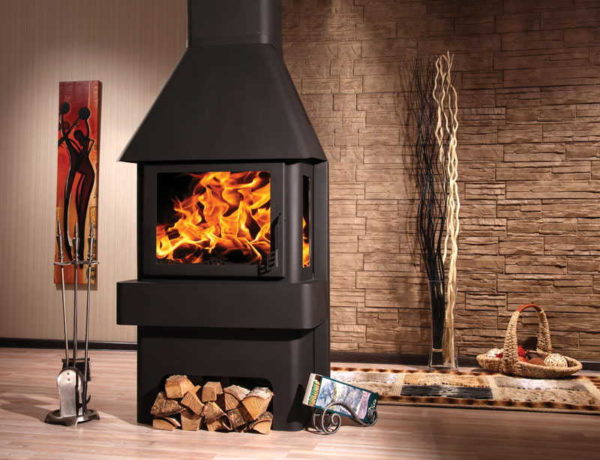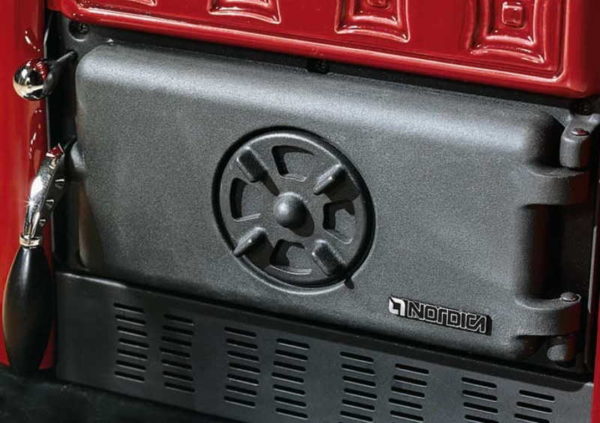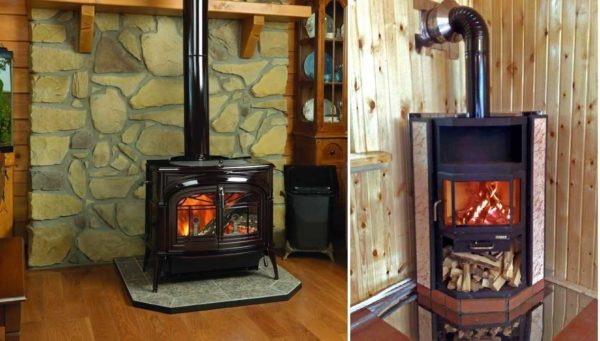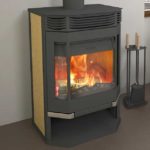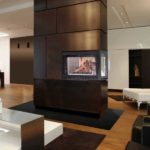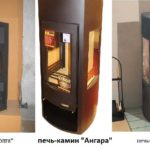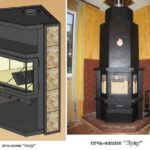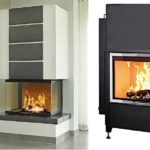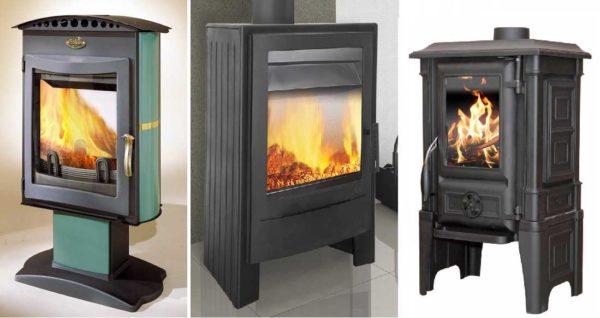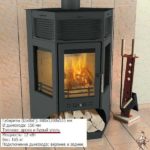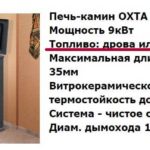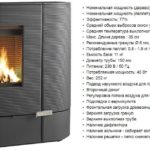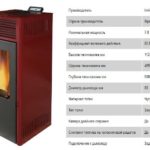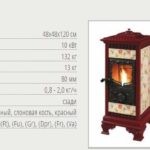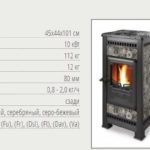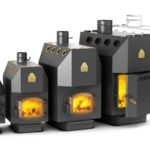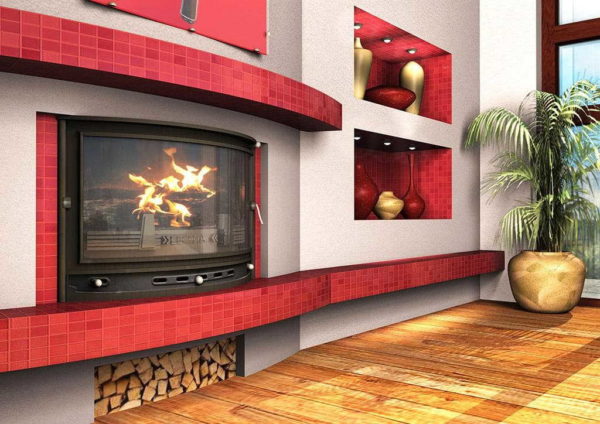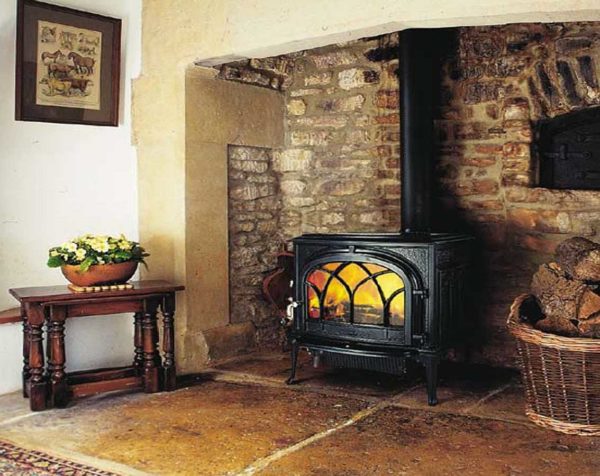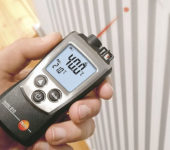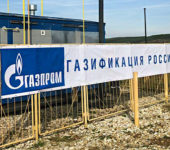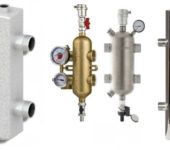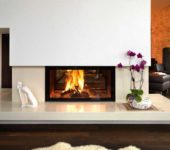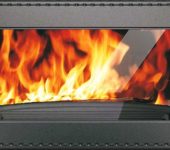Long burning fireplace stove for summer cottages - making the right choice
Equipping summer cottages for temporary visits with a full-fledged water heating system is a waste of money. This option works only if the system, in the absence of the owners, works in the “anti-freeze” mode, constantly maintaining + 5 ° C. In other cases, heating units are used that can quickly warm up the room. For example, you can put a long burning fireplace stove for a summer residence. When installing a heater of this type, you can not only warm up the room, but also admire the flame.
The content of the article
What is long burning in heating stoves
As you know, the intensity of the fuel combustion process depends on the amount of supplied oxygen. With a sufficient amount of it, the fuel burns intensively, releasing a large amount of heat, but the bookmark burns out quickly. With a limited supply of air, combustion can go to the stage of decay, in which even tongues of flame are not always observed.
In principle, any stove can be switched to a long burning mode by manipulating the valves. Another thing is that not all of them are designed for such a regime. Conventional stoves with closed valves can even be dangerous - in smoldering mode, they can become a source of smoke or carbon monoxide. So it is better to look for a fireplace stove for a summer residence in the characteristics of which the line "long burning" is indicated and the maximum burning time of one bookmark is worth. It could be 6-18 hours.
How to determine if the stove supports long-term burning or not
One of the characteristics by which it is possible to distinguish a long-burning fireplace stove for a summer residence from a conventional heating stove is its sealed design. After all, it is necessary to make sure that the air is supplied in the right amount. No more and no less. The second sign is the presence of several adjustable dampers.
The tightness can only be checked during the firebox, but the presence of dampers is monitored visually and how tightly they block the air supply, you can also see how well they move. In some models, the air supply is regulated through the ash box. In this case, you need to look at how well it “walks”, how tightly it blocks the air supply. Although the ash drawer cannot be airtight, it should not leave large holes either. You can also track the presence of a seal on the door, a gate on the pipe. All these are criteria by which you can determine whether a given fireplace stove supports long-term burning.
With gas afterburning
What else is the difference between long-burning stoves and conventional ones? The fact that they can burn gases that are formed in the process of burning wood. In conventional furnaces, these gases escape into the chimney, since a special regime is required to ignite them - high temperature and limited air access. In long-burning furnaces, the fuel chamber can be divided into several parts. Firewood is burning in one of them, gases formed during the decomposition of fuel are in the rest. Such furnaces are also called gas generating furnaces, since it is in the smoldering mode that the largest amount of gases is formed.Tellingly, most of them have a calorific value higher than that of the fuel, during the decomposition of which they were formed. So when using conventional ovens, a lot of the heat is lost. Therefore, it is believed that a long-burning fireplace stove for a summer residence and a house is more profitable, since less fuel is required.
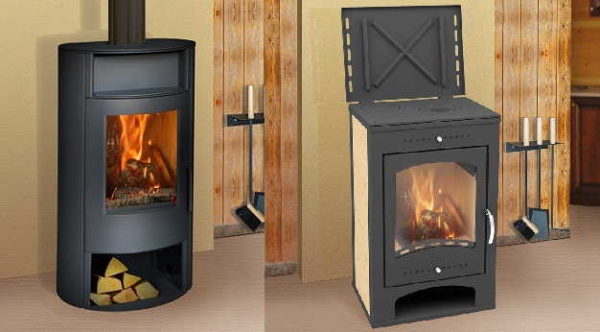
The technical characteristics should contain a line that this model supports a long burning mode. There should also be a maximum time on one tab in the long burning mode.
The downside is that a long burning fireplace stove for a summer residence or a house costs a lot of money. The price list for models that support long-term burning starts from $ 400-450 if it is a Russian manufacturer and a body made of structural steel. Domestic stainless steel costs twice as much, and cast iron - twice more. Imported fireplace stoves with a long burning function, with the same characteristics, are about 70-100% more expensive.
The difference between a classic open fireplace and a fireplace stove
A classic open-type fireplace is only an additional source of heat that cannot heat the room in cold weather. It gives heat in a small amount, it spreads only during the combustion of the fuel, and directly in front of the furnace. This type of heater is good for a wet summer or autumn / spring day. In winter, he is not able to provide a sufficient amount of heat for the entire room, since for his work good draft is needed, which "draws out" most of the heat.
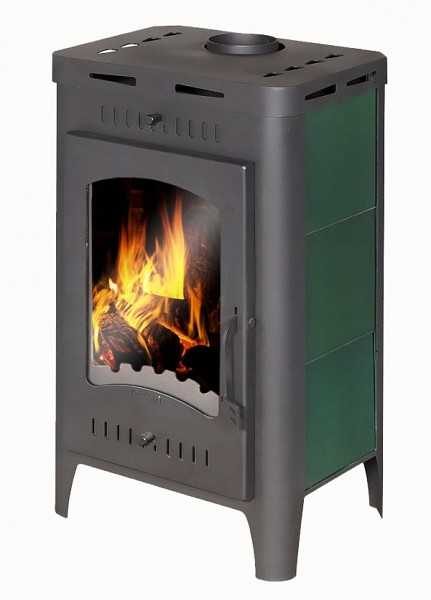
One of the simplest models: a long burning fireplace stove for a summer residence and a house "Bavaria". Manufacturer - ECOKAMIN (Russia)
The fireplace stove has other characteristics, a closed firebox. Such a unit can heat the room on its own (with the correct power). And a long-burning fireplace stove for a summer residence and at home also does it economically, as it uses the energy of the fuel to the maximum.
Types and varieties
A long-burning fireplace stove can only be of a closed type, because only with a door (also a sealed door) is it possible to regulate the oxygen supply, which is necessary to transfer the unit to a long-burning mode. Specially designed fireplace stoves differ from conventional heating stoves in the geometry of the firebox: it is wider, the window usually has a horizontal orientation (although there are also vertical models). The stove door is usually made almost the entire width of the facade, which makes it possible to admire the tongues of flame.
By design, fireplace stoves are wall-mounted (linear) and angular. Wall-mounted ones have a flat back wall and are installed at a distance of at least 2 meters from the corner. Corner corners are specially designed to fit into a corner. But when installing them, the walls to which the body adjoins must be fireproof.
There is also a special model of fireplace stoves - three-sided. Only the back wall is made of metal, the other three are made of glass. Such options are very decorative, the flame can be observed not only opposite the door, but also from almost anywhere in the room. They can be installed near the wall, like ordinary linear ones (Neman, Volga, Angara), there are corner options (Amur and Louvre), but the most interesting are built-in models with three all-glass walls, for which even special partitions are made (German company Hark).
- A specially designed firebox allows you to admire the flame from anywhere in the room
- Very unusual fireplaces are produced by the German company Hark - glass, three-walled
- There are also our three-walled metal fireplaces: Volga, Angara, Neman
- Corner models of 3-sided fireplaces: Amir and Louvre
- And such options in the German version
If we talk about a practical component, it is useful if the stove has a long burning fireplace for a summer residence in the upper part of the burner on which you can heat / cook food.In a summer residence, this is a very useful option. There are also metal fireplaces with an oven, but they hardly support a long burning mode.
There are models with a heat exchanger. This version of the fireplace stove for a permanent home. Radiators are connected to the heat exchanger and a complete hot water heating system is built. It's just that instead of a traditional heating boiler, a metal fireplace stove with a heat exchanger is used. The option is suitable for small buildings, since very powerful fireplaces of this type cannot be found.
Which fireplace stove is better: choose material
It will be about what materials a long-burning fireplace stove can be made of for a summer residence and a house. In general, metal fireplaces, to protect the walls from very high temperatures, are lined with heat-resistant materials from the inside. Most often it is fireclay bricks, but it can also be heat-resistant ceramics (more expensive models). This also leads to the fact that many models do not heat up much from the outside - you can easily hold your hand. The main heat is radiated through the door and this must be taken into account when choosing the location of the stove - the distance from the opposite wall must be greater, otherwise it will be very hot.
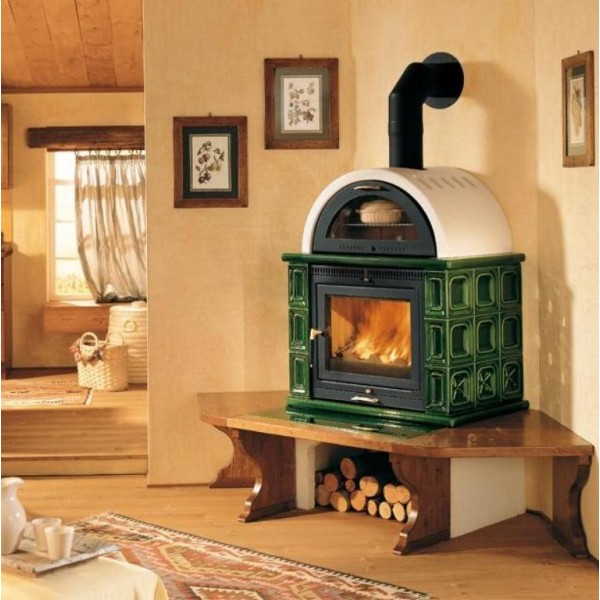
A long-burning fireplace stove for a summer residence and a house in a ceramic cladding not only looks good, but you will not burn yourself about it
In order for the walls of the heater to be safe, they are lined with heat-consuming materials such as natural stone, special ceramic tiles, etc. The second (cheaper) option is to install a metal casing that protects from touching the heated case.
Steel: black and structural
The most inexpensive fireplace stoves are made from ordinary black steel. The most budgetary option, but also the fastest burning out. To make the furnace walls last longer, they are made of considerable thickness - 5-8 mm is not the limit. To protect against corrosion, the oven is coated with special paints.
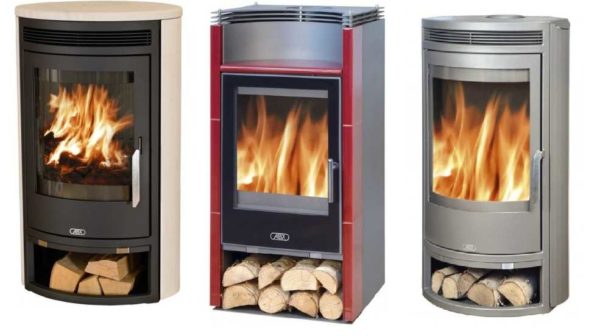
The stove is a fireplace made of black steel - the most affordable equipment (pictured are metal fireplaces from ABX, Czech Republic)
More expensive fireplace stoves are made of structural steel. This material is highly resistant to high temperatures. Due to the better heat tolerance, the wall thickness is less, but the cost of structural steel fireplaces is higher (due to the cost of the material).
Stainless steel
Heat-resistant stainless steel is used, the wall thickness rarely exceeds 3-4 mm. The surface can be matt, polished or blackened, sometimes it is painted with powder heat-resistant paints.
Stainless steel fireplace stoves are expensive, and their durability largely depends on the quality of the seams. To prevent alloying metals (which give the metal their stainless properties) from fading during welding, welding must be carried out in a protective environment. And this is complex and expensive equipment. And the price of such models, all other things being equal, is higher. But if the seams were cooked under normal conditions, the destruction of the metal begins very quickly, since it ceased to be "stainless" and heat-resistant due to high heating.
Cast iron
This material is one of the most durable. The walls of the ovens are quite thick and massive. So the cast-iron fireplace stove heats up longer, but it also cools down longer. And yet, for normal cast iron to "burn out" it takes more than one decade. But there is another risk of destruction: if water gets on a hot surface, the cast iron may crack. So, if you are thinking of buying a cast-iron fireplace stove with a stove, you will need to be very careful with it. The good news is that most of the "cast iron" is assembled from fragments on bolted connections or on the tenon / groove principle. In the event of a failure, the oven can be disassembled, only the required part can be ordered and replaced. But this is only possible if the model has not been discontinued.
There is one more thing: cast iron is a heavy thing. Therefore, when buying, pay attention to the weight.Stoves weighing up to 200 kg (with fuel filling and chimney) can be installed without a separate foundation. Even so, if the floor is wooden, additional reinforcing beams may be needed.
Type of fuel
Most fireplace stoves are designed to use wood. The type of firewood does not really matter - coniferous or deciduous species is not so important. It is important that the wood is dry. For this, many models have a shelf for storing firewood. After lighting the fireplace, a new portion is placed on the shelf, which dries up at an accelerated rate, since the temperature is higher.
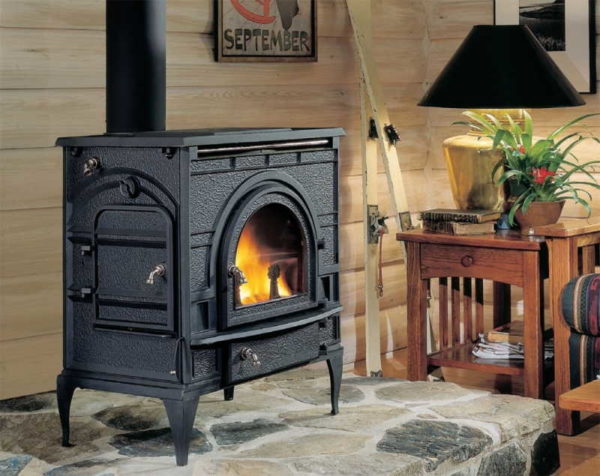
When choosing a metal or cast iron fireplace stove, pay attention to the type of fuel for which the unit is designed
There are metal fireplaces that can be heated with coal. This type of fuel provides more heat for less consumption. But when burning coal, the temperature in the furnace is much higher than when burning wood. Therefore, it is not recommended to heat a wood-burning fireplace with coal. No, you can pour coal, and it will burn well. But after a short period of time, the fireplace insert will burn out. This will happen due to the fact that the combustion temperature was much higher than "planned". If you plan to use coal periodically, you need to look for a long-burning fireplace stove for a summer residence or a house, which has the ability to heat with coal in the characteristics (black or brown also has a difference).
- Wood burning fireplace Moscow 12 (manufacturer Meta)
- Stove fireplace Okhta for firewood and brown coal
- Budget option of a cast-iron fireplace stove for coal - Torn (Thorn) manufacturer Eurokom
- French stove fireplace for pellets and wood INVICTA MIX
- Pellet stove fireplace NOLA 7 Invicta (made in France Invicta)
- Beautiful cast iron stoves fireplaces for pellets Castelmonte
- When choosing pellet stoves, pay attention to the size of the loading box
- The famous heating stove Professor Butakov from Termofor can be with a fireplace door
You can also heat a metal fireplace stove with fuel briquettes of various types, there are those that can work on fuel granules (pellets). In general, when choosing, pay attention to the type of fuel used. It is important.
Power selection
In the description of a metal fireplace stove it is necessary to indicate the heating of what area it is designed for. When choosing power, it is better to take with a margin of about 15-20%. This is in order not to overheat the body even on the coldest days. In this mode, it quickly burns out.
On the other hand, you shouldn't take too much stock. Solid fuel fireplace stoves are difficult to regulate in temperature. And, if the power of the heating equipment is several times higher than the required one, it will be too hot in the room when heating. There is nothing you can do about it. If the power is too high, there can be too much heat even in smoldering mode.
So, when choosing the power of a long-burning fireplace stove for a summer residence or at home, we take it with a margin of 15-25%. For example, the heated area is 100 sq.m. A suitable metal fireplace should have a heating capacity of 115-125 square meters.
Video review of the Kratki Koza K9 fireplace stove.
Assembly and installation
A metal stove, a fireplace of long burning for a summer residence or a house is a fire hazardous object. So the requirements for its installation are quite strict. No, permits for installation are not required, but it is better to comply with fire safety requirements - for your own safety.
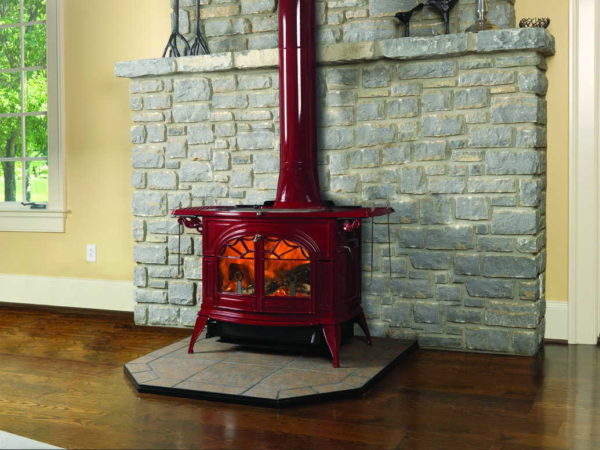
A solid fuel stove, a fireplace should stand on a non-combustible base and it is good if the walls nearby are also non-combustible or lined with non-combustible materials
How and where to install
Each manufacturer completes the soy product with instructions for installation and operation. It specifies the exact requirements for this particular model.After all, the distances to combustible structures (wooden walls, for example) depend on how much the body heats up during the furnace, and this depends on the design. And it is the manufacturer who knows the nuances of his product better, since they carry out testing in various modes. Therefore, when choosing an installation site, the distance from the walls to the case, it is better to adhere to the manufacturer's recommendations. On average, these distances are 15-25 cm. This can be useful when selecting sizes, but see the instructions for specific numbers.
When choosing a place, it is also necessary to take into account that at least 1.5 meters must remain from the fireplace door to the opposite wall. Gas pipes should not pass nearby, the electrical wiring should be at least 50 cm.
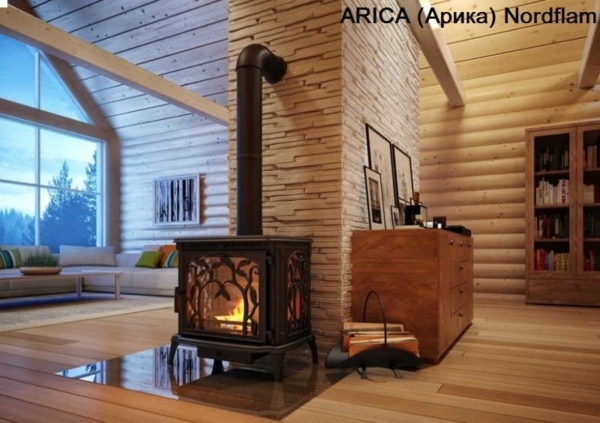
Fireproof material is placed on the wooden floor (in the photo, an example of installing the Arika Nordflam fireplace stove)
A fireproof substrate should be laid on the floor under the stove for a long-burning fireplace for a summer residence or a house. It can be a metal sheet, ceramic tile, brick, stone. The dimensions of the fireproof platform should be larger than the dimensions of the stove by 20 cm on the sides and back and 40 cm more in front.
If the floor is wooden, the easiest way is to lay a sheet of metal of the required size and thickness of 1 mm or more. A sheet of basalt cardboard (0.8-1 cm thick) is laid under it on a wooden floor, which serves for thermal insulation and protection of wood from overheating. There is another option: lay a brick on a clay mortar (half a brick thick) or ceramic tiles on heat-resistant glue on a metal sheet. In the case of using tiles for metal, it is also advisable to put basalt cardboard, but already of a smaller thickness.
Chimney
For metal fireplace stoves, a metal sandwich chimney The minimum inner diameter is 200 mm, the thickness of the insulation (basalt wool) is not less than 60 mm with the density of the insulation 15-30 kg / m³, the thickness of the inner wall made of stainless steel is not less than 1 mm. These parameters are the minimum requirements for the normal operation of the fireplace stove. A good chimney is one of the most important factors that affect the operation of the heater.
For good work, the stove, a fast-burning fireplace for a summer residence or a house, must have a chimney with a height of at least 5 meters, if you count from the grate. In addition, you must adhere to the following rules:
- The ledges are made at an angle of no more than 30 °.
- The maximum length of all horizontal sections is 1 meter.
- The chimney head is protected from precipitation and debris by means of a chimney umbrella / weather vane or any other type of head.
- It is necessary to lead the pipe through combustible structures (house wall, ceiling, roof) in a special fire-prevention section.
There is one more nuance. When burning, the fireplace stove burns out the oxygen that is in the room. A ventilation system is needed to restore it. The second option is models with external air supply to the firebox. For this, there is a special channel that leads out through the wall.

